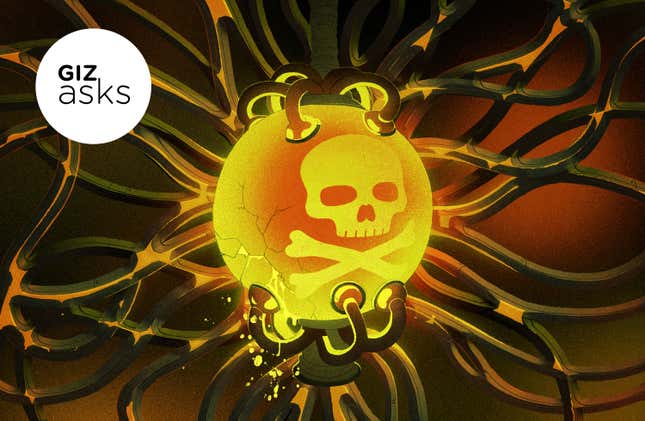
People say America doesn’t make things anymore. But what about toxic chemicals? We make so many of those, we throw half of them in rivers, for free. The problem is, it can be hard to get a handle on which of those chemicals are extremely toxic and which of them are merely somewhat toxic. If one or another shows up in a scan of your stomach, should you freak out or just be grateful it wasn’t something worse? For this week’s Giz Asks, we reached out to a number of experts to find out what the most toxic chemical is.
Peter LaPuma
Associate Professor, Environmental and Occupational Health, George Washington University
You may find good agreement on this question but some may disagree. Most any toxicology class I took would say that the most toxic chemical is Botulinum Toxin. Toxicity can be measured in a variety of ways but one popular way is how much it takes to kill 50% of the individuals. We call this LD50 or Lethal Dose for 50% of the individuals. And Botulinum Toxin produced by anaerobic bacteria has a very low LD50. It can be found in spoiled foods that have been sealed off by processes like canning. Ironically, it’s also the stuff that some pay to have injected into their faces to reduce wrinkles and make us look younger, more commonly known as botox. The botox is a very dilute form of the botulinum toxin that relaxes the smooth muscles around our eyes and forehead to reduce wrinkles.
Philippe Grandjean
Adjunct Professor, Environmental Health, Harvard University
Toxicity is traditionally thought of as a result of the substance properties along with the dose plus its duration. As we have begun to identify many serious toxicants, such as lead, mercury, dioxin, and asbestos, it has become obvious what needs to be done to protect people against them. In practice, lead and other poisons have thereby become less toxic, not because they disappear, but because we at least know what to do.
But there is another factor that needs to be emphasized: Whether we know enough to make the call or not. Some industrial chemicals have turned out to be much more toxic than we thought, in part because toxicity reports were hidden by the producers. Accordingly, too little attention was paid to the possible health risks from these “secret” chemicals. Belatedly, we are now beginning to understand that the perfluorinated chemicals, such as PFOA used for raingear and non-stick kitchen utensils, are highly persistent in the environment and also much more toxic to humans than was claimed in the past. Likewise, certain pesticides, such as chlorpyrifos, thought for decades to be safe, now turn out not being highly toxic. So in my mind, the most worrisome are those secretly toxic chemicals, like PFOA and chlorpyrifos, that we are unwittingly being exposed to.
Diana Ceballos
Assistant Professor, Environmental Health, Boston University
For me lead is the most toxic chemical.
I know from toxicology that the most toxic chemicals are those that would make you sick or kill you fastest at smaller doses. However, when thinking broadly in a public health sense through history, I think that by far lead is the most toxic chemical for humans. Lead may not kill you at small doses like some more potent poisons, however lead is a silent killer as there is no safety threshold of lead in our bodies. Lead has been identified as a poison since the ancient cultures and was further reaffirmed as toxic during the Industrial Age. Lead, however, has made its way into our everyday life still today because it was used for decades in gasoline, paint, and water pipes, therefore contaminating our soil, our duelings, and our water infrastructure. It is also still found in many everyday items like electronics, jewelry, toys, and cosmetics.
Lead poisoned children often experience developmental, behavioral, and many other health problems. Lead is associated with higher criminality and adverse mental health outcomes, as well as a decline in cognitive function and intelligence. When older, lead can still continue to affect our neurological and cardiovascular health, and even cause cancer. Lastly, lead contributes to today’s public health disparities as it is often found in substandard housing affecting those in most need. Disproportionally, also those holding the most dangerous jobs and their families are at a greater risk of suffering the consequences of lead myriad of health issues.
Rita Loch Caruso
Professor, Environmental Health Sciences, University of Michigan
Botulinum toxin is considered the most toxic chemical, based on the fact that a very small amount of it—a nanogram quantity—will kill a human being. It’s a naturally occurring chemical, made by a bacteria (Clostridium botulinum). It most commonly develops when certain vegetables are not canned properly. You might know it by its pharmaceutical name, Botox—it’s used to treat certain health conditions, like chronic migraine headaches, and to smooth out wrinkles on the face. The chemical inhibits one of the chemical transmitters that goes from the nerve to the muscle to make the muscle contract. The muscles become relaxed and won’t contract. If you have a sufficient amount of this neurotoxin in your lungs, for instance, the body will stop being able to breathe.
Ricin is a close second. It’s another naturally occurring toxin, derived from the castor bean plant. Ricin targets a structure in the cell called the ribosome. It attaches to the outside of this cell structure, and then gets taken up into it, and poisons it from inside. A single ricin molecule can inactivate thousands of ribosomes in a minute—it shuts down protein synthesis very rapidly, and then the cells die. Famously, it was used in the 1978 Umbrella Assassin case, in which the Bulgarian dissident Georgi Markov was injected with a poison-tipped umbrella containing ricin while waiting for the bus. He felt a stinging pain, and subsequently died from the poisoning.
Do you have a question for Giz Asks? Email us at tipbox@gizmodo.com.